Art News and Updates from Gallereo
All the latest news from the art world, as well as what's happening here at Gallereo. If you've built a gallery at Gallereo, let us know about your experience and you and your site could feature in our blog in the coming weeks.
Wednesday 12th October 2016The AI Curator
Much has been made of the recent advancements in the nature of artificial intelligence and machine learning, but aside from a few notable exceptions that tread the line between a fun toy and actual art (here's looking at you, Deep Dream), it hasn't really touched the art world.
Many artists are fascinated by technology and explore related themes in their work, whether it's incorporating the machines themselves or taking advantage of what the machines allow them to do. This is perfectly understandable, but as the intelligences grow smarter, the scope of their role in the art world is likely to change dramatically.
Perhaps the first example of this shift comes courtesy of a collaboration between Microsoft and the Tate Britain museum in London. An exhibit in artificial intelligence dubbed 'Reaction' recently captured the annual IK prize for its exploration of the applications of machine learning to the art world. Produced by a trio of developers working at Fabrica, Angelo Semeraro, Coralie Gourguechon and Monica Lanaro, and in collaboration with Jolibrain, a group of France-based AI specialists, Reaction isn't actually an exhibit, it's 'an autonomously operating software programme'.
The majority of the exhibit is the result of its abilities.
Tony Guillan, producer of the IK prize -- since when did art prizes have producers? What a world -- in an interview with Digital Trends gave an overview of how the system works. “From the moment it launched, it’s continually scanning both databases and comparing images, trying to find works which are comparable — whether that be visually or thematically — and then publishing them online in a virtual gallery. That gallery will keep growing over the course of the exhibition and, by virtue of including up-to-the-minute news images, will become a sort of time capsule of this period.”
“Reaction has learned to do something we can’t do, which is to scan up-to-the-minute photography and the entire Tate collection in nanoseconds. At the same time, when we look at pictures, there are numerous frames of reference we’ll use to judge them based on our lived experiences. The main job of a human curator is to put artworks together in a way that creates new meanings through comparisons or contrasts. A machine doesn’t do that. The meaning is produced by the human audiences who fill in the extra connections for themselves.”
Check out the online galleries for yourself at http://www.tate.org.uk/whats-on/tate-britain/exhibition/recognition
Posted on October 12th 2016 on 07:43pm
0 Comments
Friday 07th October 2016But is it Art?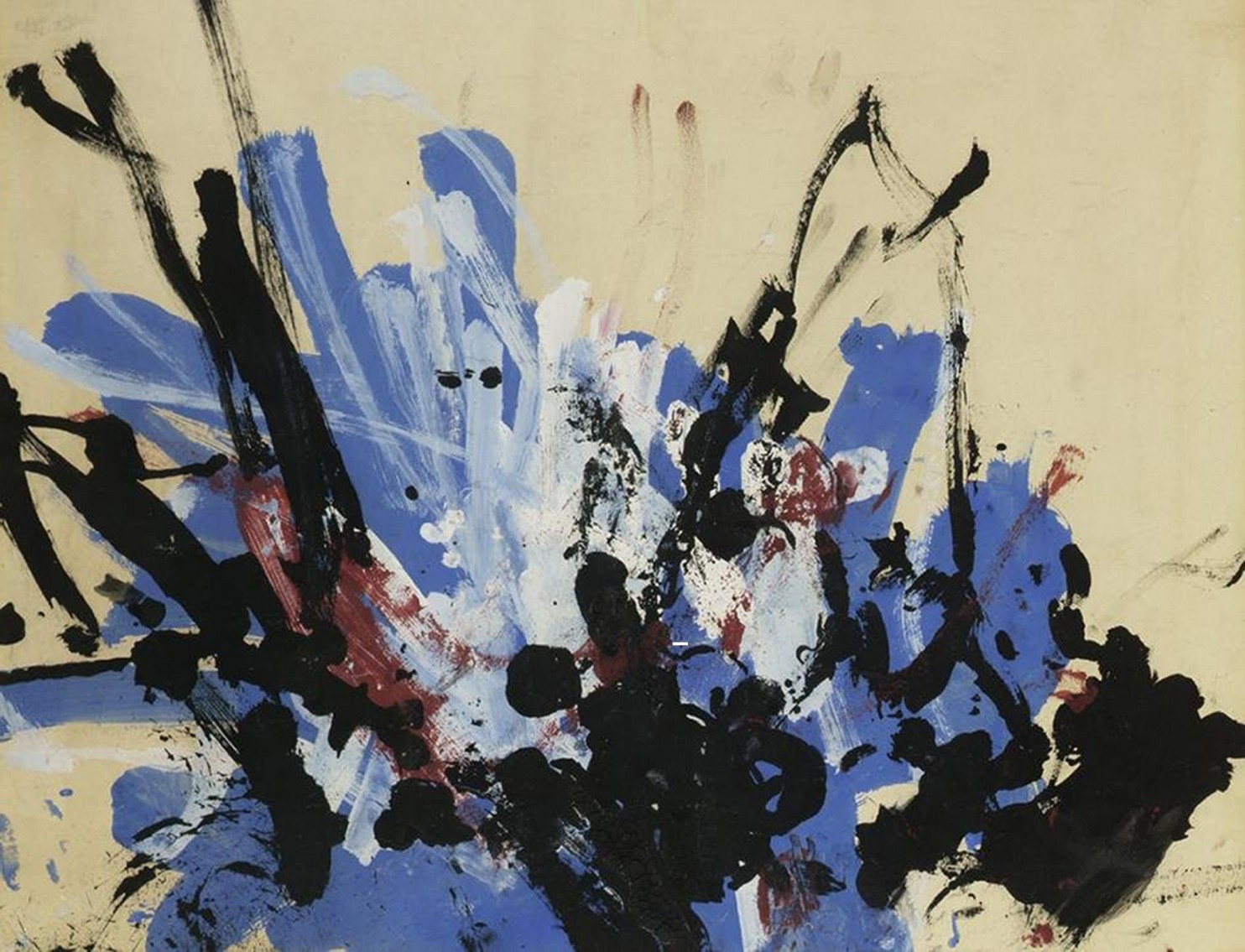 Sometimes it feels like after the number of articles we've written entitled 'But Is It Art?' or some variation thereof, we should just go ahead and make it a series like our Artist Spotlight. There are a number of interesting issues involved in the whole question and there surely is enough material to make an interesting series, but sometimes the question can seem a bit tiresome and should really just be answered 'Yes - now stop asking'.
Sometimes it feels like after the number of articles we've written entitled 'But Is It Art?' or some variation thereof, we should just go ahead and make it a series like our Artist Spotlight. There are a number of interesting issues involved in the whole question and there surely is enough material to make an interesting series, but sometimes the question can seem a bit tiresome and should really just be answered 'Yes - now stop asking'.
In today's iteration of the theme, we're going to take a closer look at art by animals. Yes, not art depicting animals, but actually created by them. An interesting article appeared in the Washington Post recently by an anthropologist at the University of Illinois at Urbana-Champaign, and while it certainly provided an interesting and engaging look at some of the more prominent animal artists of the last half century or so, the one thing it absolutely failed to do was answer the question 'But is it art?'.
Understandably, the author comes off as rather ambiguous about which way to answer the question, deciding in the end for the old standby, 'it depends on your definition'.
"If art is in the eye of the beholder, then Congo’s sweeping blazes of color can rival those of Jackson Pollock. If your notion of art is an exterior expression of an inner self, then maybe Chandra the Oklahoma City Zoo elephant’s paintings reveal less about her subjectivity than, say, how she might communicate through sounds and movement as the matriarch of a group of elephants in the wild.
But for primates such as Washoe, a chimpanzee who was raised like a human child by American scientists and died in 2007, the case may be different. Like Washoe, a few other primates have lived bicultural lives in human worlds as the subjects of language and cognition research, and can “talk” to us through signs and symbols. We may see something different in their creations, especially when they can title them themselves."
I think it's time that we disregard the equivocation and accept that no matter which way you go, there will be someone prominent and respected who disagrees with you, and therefore you're not helping yourself or anyone else by sitting on the fence about this - and certainly not the animals, unless you argue that any exposure they get is likely to increase the sales of their work and thus increase the fundraising ability of their parent zoos.
In short, yes, it is art. Whether it is a cross-species collaboration or not.
(Photo credit: Piece by Congo, photo by Bonhams/AP)
Posted on October 07th 2016 on 08:24pm
0 Comments
Wednesday 05th October 2016Artist Spotlight: Makoto Azuma
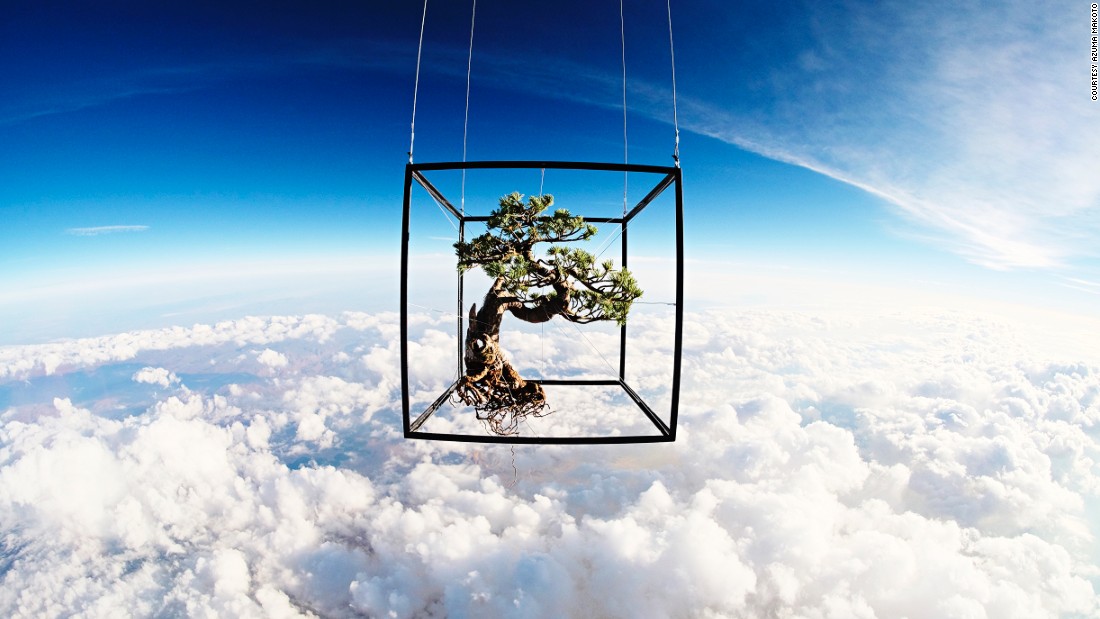
We live in incredibly exciting times, no matter what part of the world you choose to dedicate yourself to, but few things are more fascinating to the human race as a whole than what lies beyond our world. Ever since the fabled Space Race of the mid-20th century, aerospace technology has been moving forwards in leaps and bounds, but it still was generally the area of nations rather than individuals. It was simply ridiculously expensive to get anything up out of the gravity well.
Except, of course, for balloons - and Makoto Azuma decided to take that cheap method of flight and send up some truly astonishing satellites.
Well, perhaps they're not satellites in the strictest technical sense, as they're only kept aloft by the lifespan of the balloons rather than a planetary orbit, but they're still pushing the boundaries of art in a literal physical sense. Azuma has become famous for working directly with nature and living media to create his artwork, whether it's bonsai trees, fungi, or something in between.
Probably Azuma's most famous piece was entitled Exobiotanica, which featured a 50 year old Japanese white pine bonsai tree and an exquisite bouquet of Mother's Day flowers into the atmosphere - 30,000 meters up, to be precise. The two objects were then photographed by a camera that travelled with them, creating some truly beautiful images.
"Many misunderstand me as a contemporary artist, or drawer, or sculptor. But I create living art. I am creating a totally new way of expression."
In an interview with CNN Style (oddly enough), he expands on what inspired him to begin working in this truly unique medium.
"While I was running a flower shop, putting together bouquets and decoration, I thought I could find a new type of flower by applying a new expression on the flowers themselves. Besides merely making bouquets as presents or table top decoration, I thought it would be possible to capture the beauty in a photograph or video while the flower is changing its shape. It is like slicing out a moment for keeping the beauty eternal."
A beautiful sentiment, and while Azuma tends to shy away from the traditional art world - he avoids traditional artists as inspiration, and does not draw comparisons between himself and other working artists - he certainly has the flair for drama and beauty that mark the best of what the art world has to offer.
Posted on October 05th 2016 on 08:05pm
0 Comments
Friday 30th September 2016The Emperor Goes to Auction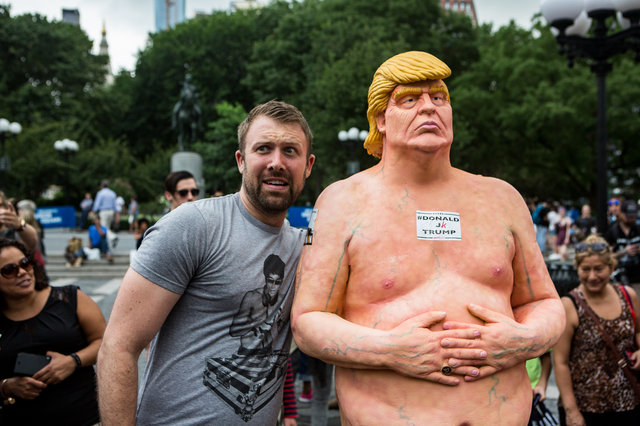 You may or may not remember one of our more hilarious stories from the past couple of months: all across America, an anarchist artist collective put up naked - and incredibly unflattering - statues of United States Republican presidential candidate Donald J. Trump. Anarchists have never been known to pull punches in any form, so the title of the statue series was as offensive as the statues themselves, "The Emperor Has No Balls". Sure enough, they left out a specific part of typical human male anatomy during the sculpting process.
You may or may not remember one of our more hilarious stories from the past couple of months: all across America, an anarchist artist collective put up naked - and incredibly unflattering - statues of United States Republican presidential candidate Donald J. Trump. Anarchists have never been known to pull punches in any form, so the title of the statue series was as offensive as the statues themselves, "The Emperor Has No Balls". Sure enough, they left out a specific part of typical human male anatomy during the sculpting process.
The statues were immediately taken down by various parks departments across the country, of course, but not before they had managed to attract thousands of deeply amused viewers, and a corresponding number of selfies with the naughty and admittedly rather repellant statue.
The New York Parks Department won the entire internet that day with their simple response to the placement of the New York version of the statue, with their spokesman tweeting, "NYC Parks stands firmly against any unpermitted erection in city parks, no matter how small".
Zing.
But the saga of this incredibly disruptive yet hilarious art series hasn't ended, as it turns out that during this coming October, an auction house located in Los Angeles (where one of the statues appeared in an park) will be selling the foam piece. Surprisingly enough, the estimated worth of the statue is between $10,000 and $20,000 USD, although it is only expected to fetch somewhere between $10,000 and $15,000 by the time the gavel falls.
The auction house responsible for the upcoming auction had the following to say in a published statement: "The explicit statue quickly became a symbol of political protest art and garnered international coverage when the gallery refused to hide or censor the statue, choosing instead to display it prominently and in public view."
It seems hard to imagine (pun intended) that someone would willingly pay $15,000 USD for an ugly foam statue of Donald Trump naked, but then Julien's Auctions was right to call it an important piece of political protest art. It's likely to only increase in value regardless of how the election goes in November, whether as a result of his defeat or his shockingly unbelievable ascendancy to the highest public office in the nation.
Either way, it's an interesting investment - except that in this case, it's probably not such a bad thing that art investors would be likely to lock it away from the public view.
Posted on September 30th 2016 on 09:00pm
0 Comments
Wednesday 28th September 2016Artist Spotlight: Dragan IlicWhen you've had a career that spans almost 50 years, it's only natural to be completely fascinated by the technological developments that you've seen over the course of your lifetime. As in the case of Serbian artist Dragan Ilic, that fascination can lead to some pretty interesting results.
Those readers of a comparable age to Mr. Ilic will have no difficulty understanding this fascination, but for those younger readers who have grown up with the internet, it probably bears pointing out that his first solo exhibit was in 1975, well before the existence of the internet and definitely before the age of ubiquitous robotic manufacturing. So try to view his latest work with the full scope of that appreciation.
As Ilic explains in his global artist statement, "The starting point in my work is conceptual analysis and de/reconstruction of the process of drawing as inscription of bodily activities on paper and opening the space for communication of ideas or realization of specific artistic intentions."
So, without further ado, here's an animated GIF of Ilic at work with one of his most recent projects, DI-2K4.
Later on in his statement, he argues, "realization and excitement felt as a result of inclusion of various auxiliary tools into the process of work, whether pencils as basic „artistic tools“ or various multifunctional technological pieces of equipment which have become an integral part of my work – have confirmed the decision to build my own artistic expression at an interaction between the body and the machine, the natural and the constructed, the intimate and the structural and the physical, symbolical and imaginary space."
Aside from being an impressive sentence - yes, that was one sentence - you can't deny that he can write one hell of an artist statement. Whether or not you accept what he has to say about the nature of his artistic practice is naturally up to you, but this writer is definitely a fan of his latest ongoing work, which is entitled 'PEOPLE I DON'T LIKE', and recently has added a continuation based around installations at seven sites across the United States where he'll be performing/creating site-specific symbolic portraits.
One wonders if he ever gets too dizzy to continue, or if he simply really enjoys this process at a basic physical level. Perhaps there's truth to the saying that we always suffer for our art.
Posted on September 28th 2016 on 08:36pm
0 Comments
Friday 23rd September 2016The Worst Ferry Disaster You Never Heard Of It's not as terrible as the headline sounds, trust me. Instead, it's something far more hilarious.
It's not as terrible as the headline sounds, trust me. Instead, it's something far more hilarious.
Recent visitors to New York and Staten Island have been privy to one of the best-kept nonexistent secret tragedies to befall the United States: The Staten Island Ferry Octopus Attack. No, you didn't miss a news headline - it's all an elaborate stunt by artist Joe Reginella to dupe tourists into searching for a nonexistent museum.
Dubbed "Staten Island Ferry Disaster Memorial Museum", the museum was promoted in some fake brochures passed out around the New York area. Some of the more gullible tourists felt the need to excoriate the United States for concealing such a tragic accident, although it's likely that they'll simply pretend they were in on the joke.
A beautiful statue was erected on the Staten Island Ferry Docks for a brief time, commemorating the "disaster", and we can only hope that it will be retained somewhere as an ongoing exhibit, even if it's necessary to inform visitors that it never really happened.
Reginella describes the entire project as "part practical joke, part multimedia art project, part social experiment."
Here's the elaborate description of the event from the website:
"It was close to 4am on the quiet morning of November 22, 1963 when the Steam Ferry Cornelius G. Kolff vanished without a trace. On its way with nearly 400 hundred people, mostly on their way to work, the disappearance of the Cornelius G. Kolff remains both one of New York’s most horrific maritime tragedies and perhaps its most intriguing mystery. Eye witness accounts describe “large tentacles” which “pulled” the ferry beneath the surface only a short distance from its destination at Whitehall Terminal in Lower Manhattan. Nobody on board survived and only small pieces of wreckage have been found…strangely with large “suction cup-shaped” marks on them. The only logical conclusion scientists and officials could point to was that the boat had been attacked by a massive octopus, roughly half the size of the ship. Adding to the tragedy, is that this disaster went almost completely unnoticed by the public as later that day another, more “newsworthy” tragedy would befall the nation when beloved President John Fitzgerald Kennedy was assassinated. The Staten Island Ferry Disaster Museum hopes to correct this oversight by preserving the memory of those lost in this tragedy and educating the public about the truth behind the only known giant octopus-ferry attack in the tri-state area."
Posted on September 23rd 2016 on 07:27pm
0 Comments
Wednesday 21st September 2016The Weird and Wonderful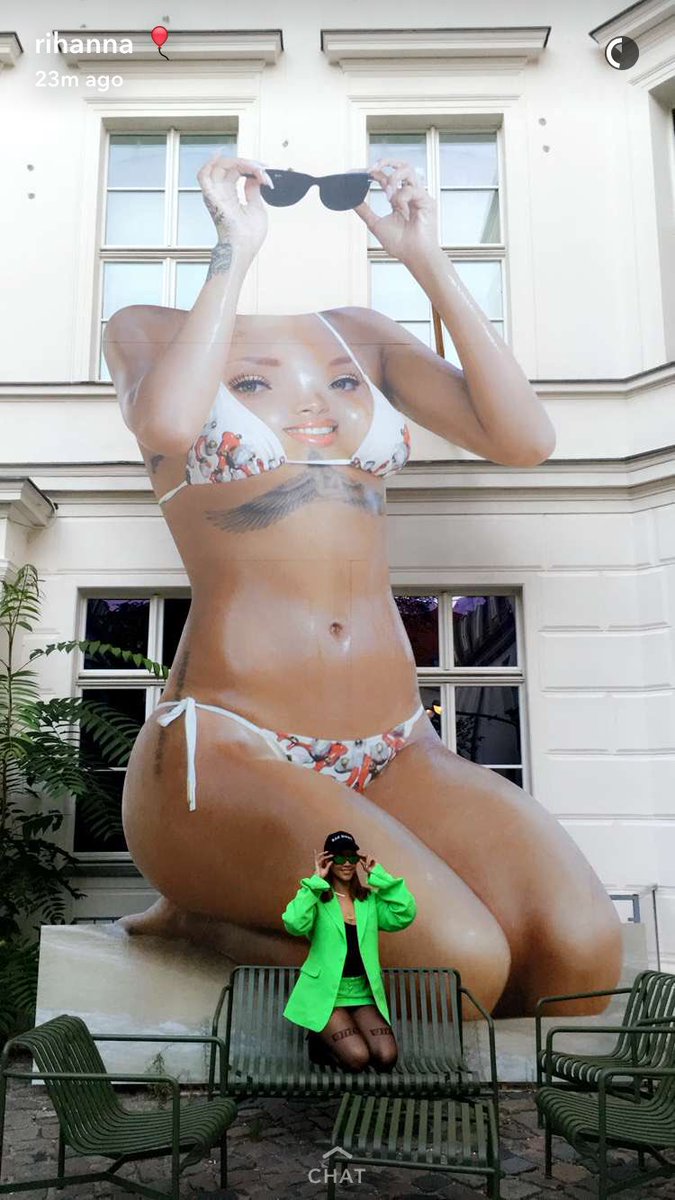 Art imitates life, and life imitates art. Old sayings are often ridiculous, but that one certainly holds true, especially in an age of social media photography and vapid self-reflection. But there are few times when it's been more literally true than during a recent moment in Berlin.
Art imitates life, and life imitates art. Old sayings are often ridiculous, but that one certainly holds true, especially in an age of social media photography and vapid self-reflection. But there are few times when it's been more literally true than during a recent moment in Berlin.
A large statue of American pop star Rihanna was unveiled in June as a part of the ninth iteration of the Berlin Biennale for Contemporary Art. Built by Colombian sculptor Juan Sebastián Peláez and entitled Ewaipanoma (Rihanna), the statue is a much larger than life version of Rihanna, clad in nothing but a bikini. The only thing missing from the statue is her head, while a 'to scale' version of her face is plastered across her chest as the sculpture holds up sunglasses to hide her nonexistent head.
So what better way to reflect on the absolute insanity of that old saying than to see a picture of Rihanna visiting the sculpture of herself and striking the same pose?
One can't help but wonder if the accompanying photo (credit: Hayden Manders) is a work of art in and of itself. In the technical sense, it is, as in 'he has copyright to this piece of imagery', but what about from a formal aesthetics sense?
If we accept Richard Prince stealing other people's Instagram photos, enlarging them and claiming to have modified them enough to distinguish his own copyright (backed up by the American legal system), is a photograph of a sculpture a work of art in its own right? Especially one that actually (whether intentionally or not) makes a commentary about the nature of that work?
It seems like a far more valid premise than Prince's, to this writer at least. Perhaps there's an interesting photo series to be made there, with each photo starring one person and the sculpture that supposedly represents them.
Probably not a great way to make friends in the art world, as Prince has found out. However, the art world does also love a rebel, regardless of whether or not they actually like them. No matter which side you come down on, there's something weird and wonderful about this photo - and perhaps it wouldn't last as a series, since the spontaneity would be lost.
What do you think? Feel free to let us know in the comments below.
Posted on September 21st 2016 on 07:06pm
0 Comments
Friday 16th September 2016Does Defacing an Artwork Create a Copyright?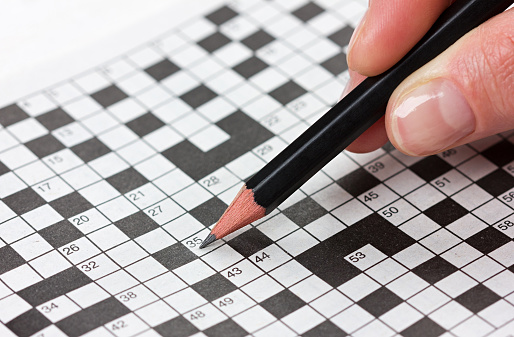 It's more or less an open secret that the legal system's understanding of the nature of art is deeply flawed. Of course, both sides of the argument tend to believe it's flawed in the other direction, as in the case of the work of Richard Prince that we've covered extensively here in the past.
It's more or less an open secret that the legal system's understanding of the nature of art is deeply flawed. Of course, both sides of the argument tend to believe it's flawed in the other direction, as in the case of the work of Richard Prince that we've covered extensively here in the past.
What makes a collaborative work of art? Does a remix constitute copyright infringement or creative license? It's the quintessential question of the postmodern world - and even if you think we're living in the post-postmodern world, the legal system still hasn't really caught up.
But regardless of how carefully you've been following these struggles over the years, you probably never expected that a 90 year old woman from Germany would be at the centre of the debate.
The woman, whose name was reported as Hannelore K. by German authorities, was visiting the Neues Museum in Nuremberg and stopped to admire a piece by 20th century avante-garde artist Arthur Kopcke. The piece, apparently entitled "Reading-work piece" (probably a terrible translation from the German, apologies that we can't find the proper name), features a blank crossword grid. Beside the piece is a sign in English that says 'Insert Words'.
So that's exactly what she did. She began to fill in the crossword puzzle squares, and managed quite a few before museum officials stopped her and called the police.
She was released after briefly being questioned by the police, but the story doesn't end there. While that alone would probably be enough for the basis of an article, the really juicy bit comes in the form of her response.
She's suing the museum for removing her additions to the artwork, claiming that she has a new copyright on the collaborative result of her tweaks to the piece. Whether this is her opinion or the suggestion of her lawyer remains to be seen, but it's a story that strikes straight to the heart of the question of the nature of media and art.
Interestingly enough, the Fluxus school which Kopcke was a member of during his career, doesn't seem to support the museum's decision to "restore" the work. As Ars Technica quoted The Art Story:
"Fluxus artists did not agree with the authority of museums to determine the value of art, nor did they believe that one must be educated to view and understand a piece of art."
Posted on September 16th 2016 on 06:41pm
0 Comments
Wednesday 14th September 2016Artist Spotlight: Spencer Tunick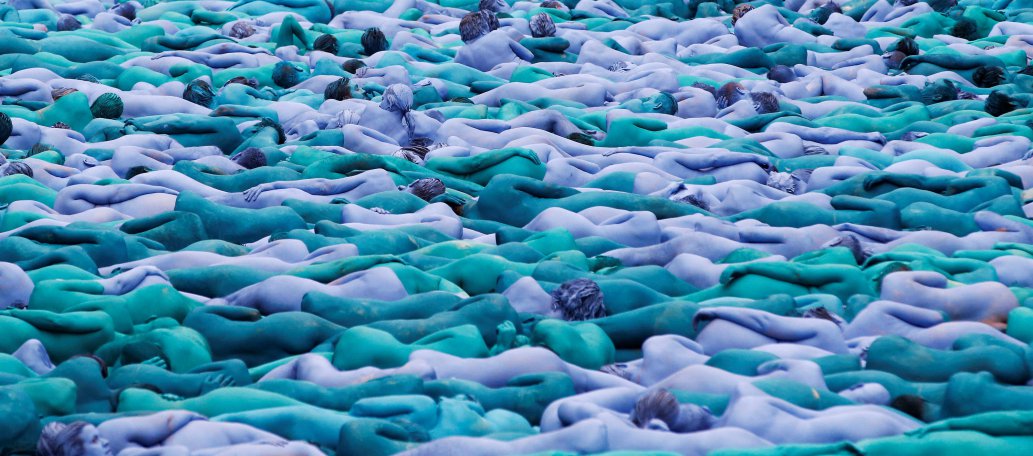 Would you get naked for art? This writer probably wouldn't, but that doesn't mean there aren't a number of people who would. Quite a large number, in fact. So large a number that photographer Spencer Tunick was able to achieve his dream of painting the town blue.
Would you get naked for art? This writer probably wouldn't, but that doesn't mean there aren't a number of people who would. Quite a large number, in fact. So large a number that photographer Spencer Tunick was able to achieve his dream of painting the town blue.
Not literally, though, because it was actually the naked volunteers who were painted blue from head to foot. Over 3200 people showed up to volunteer to be a part of the shoot, which is a rather impressive figure, pun intended (apologies).
The shoot took place in Kingston Upon Hull in England, as part of an art project called "Sea of Hull", which is a celebration of the region's rich maritime culture and history.
“I can’t believe it,” Tunick said in an interview with the Daily Mail. “It was cold, it was chilly, people had to put lotionlike paint all over their bodies — every part.
“It’s beautiful. We are little strokes of paint. Everybody is equal.”
Certainly an admirable sentiment, even if it only lasted as long as the photoshoot.
One wonders if the Guinness Book of World Records has an entry for the largest gathering of naked people in body paint or something similar, because if not, maybe it's time to create a new entry.
The thing is, it's possible that Spencer Tunick might be the all-time champion in the category, since the entirety of his body of work involves large-scale naked photoshoots (again, pun intended). In fact some of his shoots have involved tens of thousands of naked volunteers, although they were absent the bright blue bodypaint.
While it might seem a bit silly at first, it's actually an interesting exploration of privacy in a public world. All of his shoots take place in recognizable public places, where we are traditionally covered up. Even dedicated nudists generally don't seem too interested in being naked in public when others are clothed.
However, his work has been regarded with some suspicion in his native America, where he has been arrested five times in New York City alone since 1992. He's filed civil rights lawsuits to protect himself and his participant volunteers, but has since decided to take his work out of the more puritanical United States and explore work in parts of the world who are less ashamed of the naked human form.
Of course, one could argue that this would diminish the impact of his work, but it's probably better to be out of jail and still creating than in jail for your artistic sensibilities.
Photo credit: Reuters / Andrew Yates
Posted on September 14th 2016 on 09:29pm
0 Comments
Friday 09th September 2016Google Launches New Arts and Culture App.jpg)
It's hard to be Google without having an incredible amount of information in your database. The whole function of what they do is based around having the best searchable index of information, after all. But what about information that doesn't exist as part of a webpage?
As artists, we're well aware of the fact that there is just as much data in imagery as there is in text, but tagging and searching that data is a monumental task. Fortunately for us, Google has been working on this difficult problem for quite some time, and has built up an incredible database of cultural history under the admittedly less than creative name Google Arts and Culture.
Aside from the slightly boring name, however, the tool itself is absolutely incredible. There is such a vast amount of information available that almost anything you could possibly want to find out about is there, whether it's a piece of contemporary modern art or something from the stone age.
But even more impressively, the app doesn't just contain information about all of these cultural artifacts, but actually visit them within the app. When pairing your smartphone with a cheap virtual reality headset, you can walk past your favourite Banksy piece on the virtual street or visit a temple constructed in ancient Greece.
Google has also partnered with a number of art galleries around the world to share museum data such as open hours and ongoing exhibits, as well as log their current collections as part of a database. Opening the app while actually in one of the museums and scanning the piece you're standing in front of with your phone will allow you to pull up a huge amount of information about it.
Unfortunately, only three museums are currently participating in the program, but naturally this is likely to increase dramatically once word of the app gets out to curators. It would certainly be most advantageous for them to work with Google rather than developing their own unique augmented reality apps and experiences.
The three museums that are currently participating are the Dulwich Picture Gallery in London, the Art Gallery of New South Wales in Sydney, and the National Gallery of Art in Washington, DC.
Probably the most interesting aspects of the project is the way you can sort the results of your own searches. This allows you a variety of ways to look at the progression of art history, from how cats have been represented since ancient Egypt or the relative impacts of various seminal pieces in a specific genre or movement.
The app is available for Android and iOS, or you can visit the website itself at https://www.google.com/culturalinstitute/beta/
Posted on September 09th 2016 on 08:09pm
0 Comments
 Sometimes it feels like after the number of articles we've written entitled 'But Is It Art?' or some variation thereof, we should just go ahead and make it a series like our Artist Spotlight. There are a number of interesting issues involved in the whole question and there surely is enough material to make an interesting series, but sometimes the question can seem a bit tiresome and should really just be answered 'Yes - now stop asking'.
Sometimes it feels like after the number of articles we've written entitled 'But Is It Art?' or some variation thereof, we should just go ahead and make it a series like our Artist Spotlight. There are a number of interesting issues involved in the whole question and there surely is enough material to make an interesting series, but sometimes the question can seem a bit tiresome and should really just be answered 'Yes - now stop asking'.
 We live in incredibly exciting times, no matter what part of the world you choose to dedicate yourself to, but few things are more fascinating to the human race as a whole than what lies beyond our world. Ever since the fabled Space Race of the mid-20th century, aerospace technology has been moving forwards in leaps and bounds, but it still was generally the area of nations rather than individuals. It was simply ridiculously expensive to get anything up out of the gravity well.
We live in incredibly exciting times, no matter what part of the world you choose to dedicate yourself to, but few things are more fascinating to the human race as a whole than what lies beyond our world. Ever since the fabled Space Race of the mid-20th century, aerospace technology has been moving forwards in leaps and bounds, but it still was generally the area of nations rather than individuals. It was simply ridiculously expensive to get anything up out of the gravity well. You may or may not remember one of our more hilarious stories from the past couple of months: all across America, an anarchist artist collective put up naked - and incredibly unflattering - statues of United States Republican presidential candidate Donald J. Trump. Anarchists have never been known to pull punches in any form, so the title of the statue series was as offensive as the statues themselves, "The Emperor Has No Balls". Sure enough, they left out a specific part of typical human male anatomy during the sculpting process.
You may or may not remember one of our more hilarious stories from the past couple of months: all across America, an anarchist artist collective put up naked - and incredibly unflattering - statues of United States Republican presidential candidate Donald J. Trump. Anarchists have never been known to pull punches in any form, so the title of the statue series was as offensive as the statues themselves, "The Emperor Has No Balls". Sure enough, they left out a specific part of typical human male anatomy during the sculpting process.
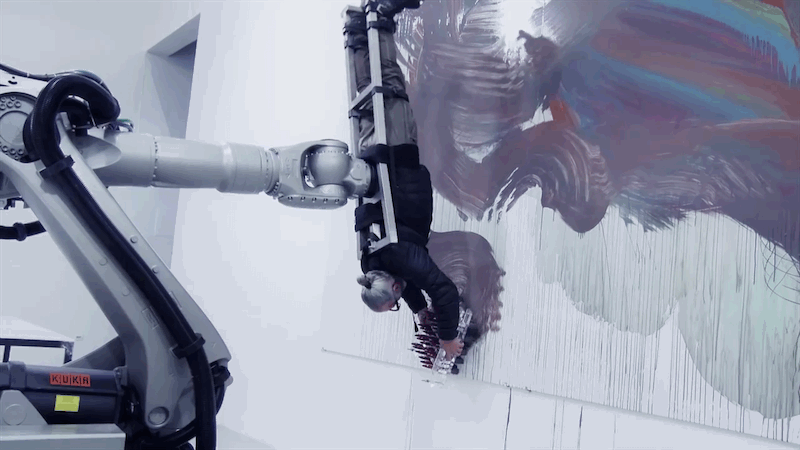
 It's not as terrible as the headline sounds, trust me. Instead, it's something far more hilarious.
It's not as terrible as the headline sounds, trust me. Instead, it's something far more hilarious.
 Art imitates life, and life imitates art. Old sayings are often ridiculous, but that one certainly holds true, especially in an age of social media photography and vapid self-reflection. But there are few times when it's been more literally true than during a recent moment in Berlin.
Art imitates life, and life imitates art. Old sayings are often ridiculous, but that one certainly holds true, especially in an age of social media photography and vapid self-reflection. But there are few times when it's been more literally true than during a recent moment in Berlin.
 It's more or less an open secret that the legal system's understanding of the nature of art is deeply flawed. Of course, both sides of the argument tend to believe it's flawed in the other direction, as in the case of the work of Richard Prince that we've covered extensively here in the past.
It's more or less an open secret that the legal system's understanding of the nature of art is deeply flawed. Of course, both sides of the argument tend to believe it's flawed in the other direction, as in the case of the work of Richard Prince that we've covered extensively here in the past.
 Would you get naked for art? This writer probably wouldn't, but that doesn't mean there aren't a number of people who would. Quite a large number, in fact. So large a number that photographer Spencer Tunick was able to achieve his dream of painting the town blue.
Would you get naked for art? This writer probably wouldn't, but that doesn't mean there aren't a number of people who would. Quite a large number, in fact. So large a number that photographer Spencer Tunick was able to achieve his dream of painting the town blue.
.jpg) It's hard to be Google without having an incredible amount of information in your database. The whole function of what they do is based around having the best searchable index of information, after all. But what about information that doesn't exist as part of a webpage?
It's hard to be Google without having an incredible amount of information in your database. The whole function of what they do is based around having the best searchable index of information, after all. But what about information that doesn't exist as part of a webpage? 



